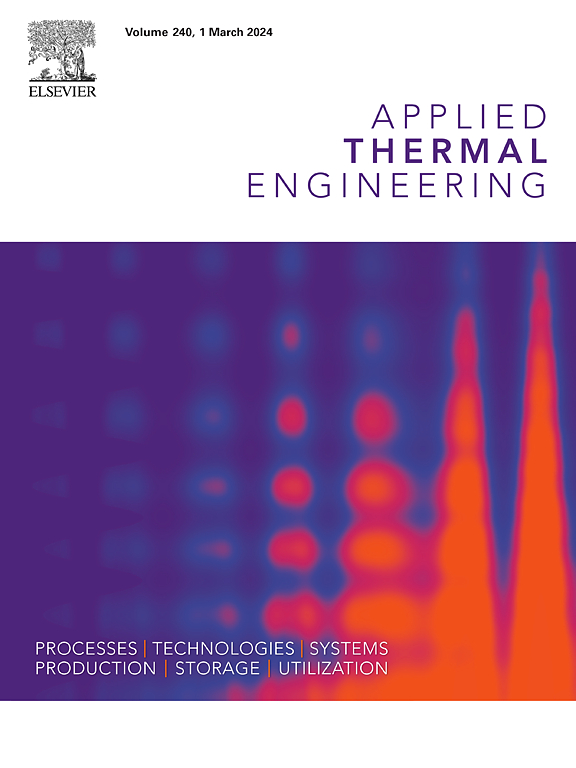The synergistic effect of micro/nanostructure length scale and fluid thermophysical properties on pool boiling heat transfer
IF 6.1
2区 工程技术
Q2 ENERGY & FUELS
引用次数: 0
Abstract
Facile surface micro/nanostructuring techniques for additively-manufactured (AM) aluminum alloy (AlSi10Mg) have recently been developed. The structuring techniques are not only highly scalable, but they also enable the tailoring of structure length scale and morphology to enhance pool boiling heat transfer coefficient. Our past study revealed that the structure cavity size of 5 µm is favorable for bubble nucleation during pool boiling of dielectric fluid, HFE-7100, resulting in significant enhancements in the heat transfer coefficients (h). However, owing to the differences in thermophysical properties between different coolant fluids, including saturation temperature, latent heat of vaporization and surface tension, the required structure size range for bubble nucleation and capillary wicking force for liquid re-supply are expected to differ significantly. To explore the effect of structure length scale on the pool boiling performance of coolants with different thermophysical properties, this work develops a new surface structuring technique consisting of a dual-stage metallurgic heat treatment process and single-stage crystallographic etching process to tune the structure length scale across nearly two orders of magnitude, viz., from 0.3 to 15 μm. Using coolant media of vastly different thermophysical properties, i.e., dielectric fluid HFE-7100 and deionized water, we show that while microcavities with sizes ranging from 3 to 8 μm are favorable bubble nucleation sites for boiling of HFE-7100, which result in the enhancement of the maximum heat transfer coefficient (hmax) by 83.4 to 103.8 % as compared to a conventional plain Al6061 surface, larger microcavity sizes of 10 to 15 μm are required to effectively promote bubble nucleation of water. This large microcavity size range of 10 to 15 μm, produced through rational nanoparticle agglomeration of the rich Si-phase in AM AlSi10Mg in elevated temperature, followed by an indirect removal process using a chemical process, is found to significantly increase hmax of water by up to 259.9 % as compared to conventional nanostructures formed on Al6061. In addition, the new AM structured surfaces also exhibit up to 26.6 % enhancement in critical heat flux (CHF) as compared to highly-wicking conventional nanostructured Al6061. In summary, by utilizing scalable fabrication techniques to tailor the structure length scale on AM AlSi10Mg, this work not only reveals the favorable microcavity sizes for bubble nucleation of different coolant fluids to enhance boiling, but it also provides useful micro/nanostructure design guidelines that can be adopted to enhance boiling of other coolants and phase change applications.
微/纳米结构长度尺度和流体热物理性质对池沸传热的协同效应
最近,针对快速成型(AM)铝合金(AlSi10Mg)开发出了简便的表面微/纳米结构技术。这种结构化技术不仅具有高度的可扩展性,而且还能定制结构的长度尺度和形态,以提高池沸腾传热系数。我们过去的研究表明,5 微米的结构空腔尺寸有利于介质流体 HFE-7100 的池沸腾过程中气泡成核,从而显著提高传热系数(h)。然而,由于不同冷却剂流体的热物理性质(包括饱和温度、汽化潜热和表面张力)存在差异,因此气泡成核所需的结构尺寸范围和液体再补给所需的毛细管吸力预计会有很大不同。为了探索结构长度尺度对不同热物理性质冷却剂池沸性能的影响,本研究开发了一种新的表面结构化技术,包括双阶段冶金热处理工艺和单阶段晶体蚀刻工艺,以调整结构长度尺度,使其跨越近两个数量级,即从 0.3 微米到 15 微米。使用热物理性质迥异的冷却介质,即我们使用热物理性质迥异的冷却介质,即介质流体 HFE-7100 和去离子水,结果表明,3 至 8 μm 大小的微腔是 HFE-7100 沸腾的有利气泡成核点,与传统的普通 Al6061 表面相比,最大传热系数 (hmax) 提高了 83.4% 至 103.8%,但要有效促进水的气泡成核,则需要 10 至 15 μm 大小的更大微腔。与在 Al6061 上形成的传统纳米结构相比,通过在高温下对 AM AlSi10Mg 中富含的硅相进行合理的纳米粒子团聚,然后使用化学工艺进行间接去除,产生的 10 至 15 μm 大尺寸微腔可显著提高水的 hmax,最高可达 259.9%。此外,与高度排汗的传统纳米结构 Al6061 相比,新型 AM 结构表面的临界热通量(CHF)也提高了 26.6%。总之,通过利用可扩展的制造技术来定制 AM AlSi10Mg 上的结构长度尺度,这项工作不仅揭示了有利于不同冷却剂流体的气泡成核以增强沸腾的微腔尺寸,还提供了有用的微/纳米结构设计指南,可用于增强其他冷却剂的沸腾和相变应用。
本文章由计算机程序翻译,如有差异,请以英文原文为准。
求助全文
约1分钟内获得全文
求助全文
来源期刊

Applied Thermal Engineering
工程技术-工程:机械
CiteScore
11.30
自引率
15.60%
发文量
1474
审稿时长
57 days
期刊介绍:
Applied Thermal Engineering disseminates novel research related to the design, development and demonstration of components, devices, equipment, technologies and systems involving thermal processes for the production, storage, utilization and conservation of energy, with a focus on engineering application.
The journal publishes high-quality and high-impact Original Research Articles, Review Articles, Short Communications and Letters to the Editor on cutting-edge innovations in research, and recent advances or issues of interest to the thermal engineering community.
 求助内容:
求助内容: 应助结果提醒方式:
应助结果提醒方式:


